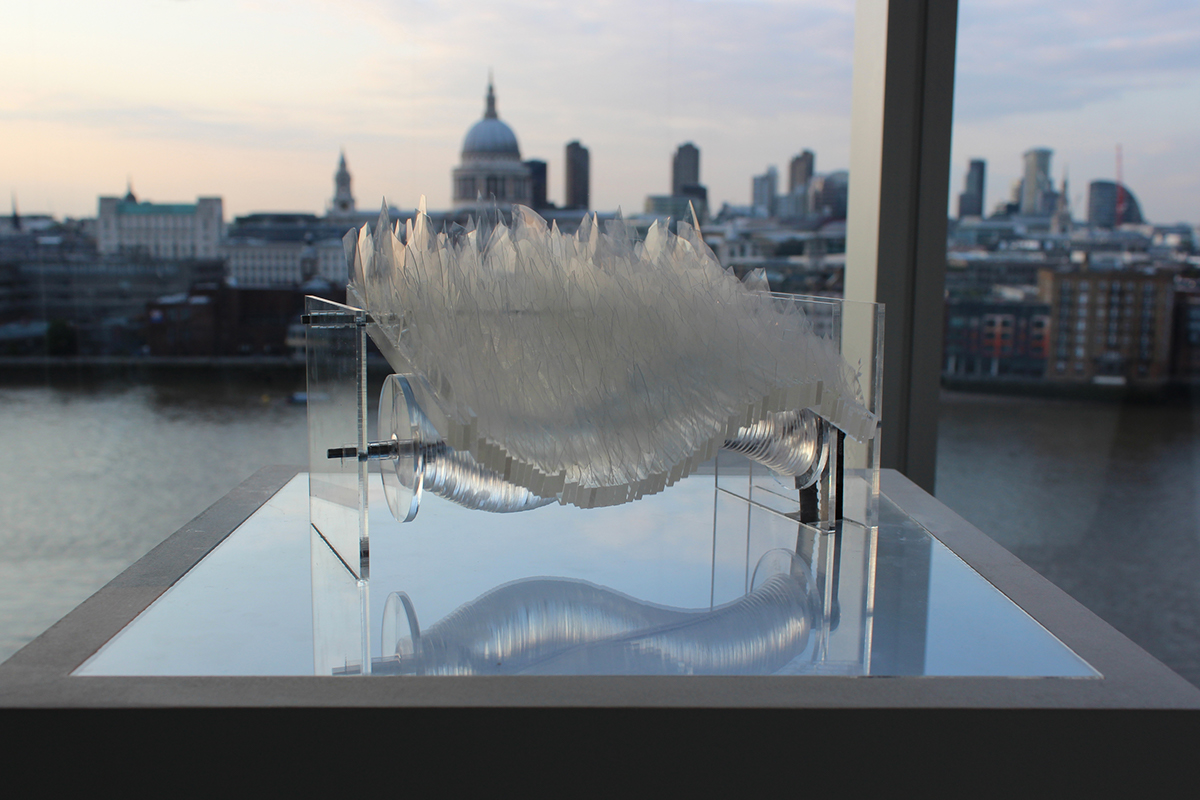Floe
*** Selected Artwork for QEPrize Showcase for Modern Engineering @ Tate Modern, London
June 25, 2013
June 25, 2013

Tate Modern, London, June 25, 2013
“Floe” embodies the shape and movement of ice drifting on the surface of the North Atlantic. In this region shards of ice drift freely along the surface of the water, and slight changes in tide and intense northern lights bring life to the environment. The piece is inspired by formations and movement found in nature.
This second version of the piece presents the very same glass structure with a different lighting solution. Rather than using a projector, this time the glass piece is lit by thin strips of LED positioned below the light diffusing base of the structure. The light box built for this particular demonstration is to be later simplified by hiding all the electronic components that make the structure dynamic, in a plinth that actually carries the work itself. The only aspect of the work to be visually experienced by the viewer is the wave structure itself and it's water-like base surface.
Floe 2.0 uses a stepper motor programmed with Arduino and a proximity sensor to track the presence/detect the distance of the audience in the environment. The piece stands out as an almost static delicate art piece in a gallery space, until a viewer comes to a certain distance to the piece, then the structure comes to life and its artificial light dims out to a more natural state. This shift from "art piece as an object in a gallery space" to "art piece as a living form in public space" is the essence of the interaction Floe constitutes.
This second version of the piece presents the very same glass structure with a different lighting solution. Rather than using a projector, this time the glass piece is lit by thin strips of LED positioned below the light diffusing base of the structure. The light box built for this particular demonstration is to be later simplified by hiding all the electronic components that make the structure dynamic, in a plinth that actually carries the work itself. The only aspect of the work to be visually experienced by the viewer is the wave structure itself and it's water-like base surface.
Floe 2.0 uses a stepper motor programmed with Arduino and a proximity sensor to track the presence/detect the distance of the audience in the environment. The piece stands out as an almost static delicate art piece in a gallery space, until a viewer comes to a certain distance to the piece, then the structure comes to life and its artificial light dims out to a more natural state. This shift from "art piece as an object in a gallery space" to "art piece as a living form in public space" is the essence of the interaction Floe constitutes.
“Floe” is a collaborative act between four artists and designers from the Royal College of Art, London. Lida Marinkova (Mixed Media and Textiles), Ozgun Kilic (Animation), Oluwaseyi Sosanya (Innovation Design Engineering) and Pierre Paslier (Innovation Design Engineering).

The glass structure is combined with a simple wave movement and light bringing life to the piece. An interactive element was essential to the project; the audience influences the movement and light intensity with their presence.
This is the first prototype of an on going project, using a continuous rotation servo motor(+arduino), a distance sensor to track the presence of the audience in the environment changing the speed of rotation accordingly. A single beamer as a light source adds another layer to the whole - that being random shapes created on the walls as a result of light rays reflecting from/breaking through extremely thin glass layers.
Kinetic Sculptures (2012)
In association with Seyi Sosanya, Designer
SineWaves is the iterative exploration that lead to Floe. Interested in the mesmerizing movement of mechanical elements, we created kinetic machines at the edge of design and sculpture.
Our approach is driven by the desire to create beautiful movements based on mathematical functions.
There are iterations #2 and #3 of this on-going project.
The next generation of wave is under construction so stay tuned for our next prototype.
Our approach is driven by the desire to create beautiful movements based on mathematical functions.
There are iterations #2 and #3 of this on-going project.
The next generation of wave is under construction so stay tuned for our next prototype.
Click here to read more about Floe and our design proccess.


